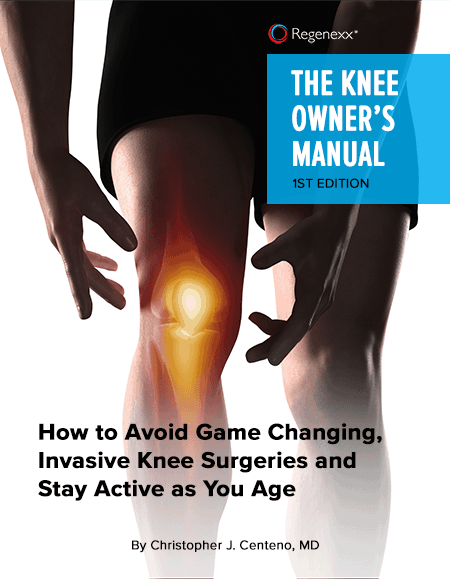CONTACT US. 703-337-3305
We understand how it feels to be frustrated by knee pain.
You may feel frustrated, anxious, and afraid. Feeling like you might not get to participate in activities you’ve always enjoyed, fearful that you might need surgery that could affect you for the rest of your life.

Are you frustrated by pain? Afraid you might need life-altering surgery?
You’re not alone. We can help.
Complete this short form and get your FREE copy of The Knee Owner’s Manual, plus receive valuable information that can help you avoid invasive surgery.
Partial knee menisectomy is a very common surgery that involves removing the torn part of the meniscus. The meniscus is a natural shock absorber for the knee. In fact, in America alone, we perform about 700,000 of these surgeries per year, making it one of the most common orthopedic surgeries. While most patients think they’re getting a meniscus repair procedure, the truth is, 96% of these surgeries just remove a piece of the shock absorber, leaving your knee less protected.
There have been many high-quality research studies over the past decade or more that were designed to answer the specific question, “Is surgery necessary for a torn meniscus?” What did they show? All three large studies showed that meniscus surgery was not effective or no better than just physical therapy.
We offer innovative non-surgical procedures that may help decrease pain and improve knee function and mobility without the need for surgery.
Meniscus surgery is traumatic and carries associated risks. Even successful surgeries require months of painful rehab to regain strength and mobility. After surgery, most patients will be on crutches, wear a brace, or some combination of both for several weeks before returning back to normal activity. The recovery time and rehabilitation period may be extended up to six weeks with a knee brace or crutches.
Keep in mind that there may even be some complications associated with meniscus surgery, prolonging the recovery period even more. This includes complications with anesthesia, such as respiratory or cardiac malfunction, infections, and injury to nerves and blood vessels, fracture, weakness, stiffness or instability of the joint, inability to repair the meniscus, repeated rupture of the meniscus, or the need for additional surgeries.
Can you ever truly recover from parts of your knee meniscus being removed surgically? In the long run, almost all meniscus surgeries accelerate degeneration that leads to osteoarthritis and exacerbate the biomechanical problems that initially led to the need for the surgery.
Meniscus tears are like wrinkles; they are unavoidable. Some of us get more of them at a young age and some of us don’t get a lot of them until we’re older. The meniscus gets small tears as we age and as the knee joint begins to wear out. For example, in middle-aged and elderly patients, taking an MRI of patients with no knee pain and those with ongoing knee pain will reveal that both groups have about the same amount of meniscus tears. If these things usually don’t cause pain, why are we operating on them? If our surgeries are no better than fake surgeries, why are we placing all of these patients at the risk of surgical complications?
Recent research shows that some of the most popular orthopedic knee surgeries, including meniscectomies, have no benefit and are not more effective than placebo or sham surgery. But can a meniscus tear heal on its own when left untreated? Non-surgical treatments for meniscus tears for healing on their own include physical therapy, rest, ice, compression and elevation. Interventional orthopedics also provides a non-surgical injection alternative that may prove beneficial in reducing pain and improving function.
Have you been told that invasive surgery is your only option to fix your torn ACL? Getting your ACL replaced permanently alters the mechanics of the knee joint. You have other options when it comes to treating your ACL injury. In fact, about 70% of all ACL tears that currently get surgery could have been treated with a precise injection.
Your body is built to repair itself and our goal is to save your ACL, not replace it. We offer a non-surgical alternative for ACL tears that requires advanced injection skills using X-ray guidance, which may aide the healing of your ACL tear, while reducing pain and increasing function.
Multiple studies show that meniscus surgery doesn’t work.
If your MRI shows a meniscus tear, you might be asking: Do I need surgery?
But here’s the more important question: Is the torn meniscus causing my knee pain?

StemCell ARTS Doctors
A physiatrist with vast experience in sports medicine and geriatric medicine, Dr. Dade approaches his patients’ pain by evaluating the whole person, not just the source of pain.
Understanding and respecting the symbiotic relationship between all systems within the human body is central to his all-inclusive approach to care and is integral to reducing pain. He is able to diagnose a variety of musculoskeletal conditions with precision and then develops comprehensive treatment plans.
In addition to being adept at conventional interventional techniques, Dr. Dade is highly skilled in regenerative medicine including: prolotherapy, platelet-rich plasma (PRP), and bone marrow concentrate.
A respected leader in his field, Dr. Dade had been recognized by his peers as one of Washingtonian magazine’s Top Doctors. He is a past recipient of the Congressional National Leadership Award for achievements in the medical community.
Areas treated: Cervical Spine (Not Upper Cervical or CCI)*, Elbow, Foot & Ankle, Hand & Wrist, Hip, Knee, Lumbar Spine, Shoulder, Thoracic Spine
Board certified in physical medicine and rehabilitation, Dr. Friedlis is one of few physicians in the Washington, DC, metropolitan area trained to perform platelet-rich plasma (PRP) treatments and is one of the first doctors in the area to use bone marrow concentrate for the treatment of musculoskeletal injuries.
His innovation and expertise has established Dr. Friedlis as the foremost practitioner of regenerative procedures for musculoskeletal injuries in the Washington, DC, area. Nationally recognized as an expert in pain, he is a frequent speaker at national conferences on regenerative treatments.
As an advocate for global stewardship, Dr. Friedlis has coordinated several medical mission trips to Central Mexico that were sponsored by the American Association of Orthopedic Medicine and provided much-needed pain management services to poor, rural communities. He also served as program director for a new medical outreach program that brought then-nonexistent pain management services to Lima, Peru.
Areas treated: Cervical Spine (Not Upper Cervical or CCI)*, Elbow, Foot & Ankle, Hand & Wrist, Hip, Knee, Lumbar Spine, Shoulder, Thoracic Spine
A native of Northern Virginia, Dr. Wagner returned to the area after completing his medical training throughout the state of Virginia. He believes that finding the definitive source of pain is critical to long-term recovery.
He combines his years of clinical experience and skills in advanced, non-surgical techniques with the latest medical technology with the goal of improved function and reduced pain for each patient and has helped countless patients resolve complex pain issues and return to healthy lives.
Dr. Wagner specializes in diagnosing and treating injuries of the spine, joints, tendons, nerves and ligaments by utilizing injection techniques. He is well-respected within his field and has lectured and mentored clinicians nationally on these innovative techniques and their application for treating chronic pain conditions.
He is frequently asked to share his expertise through speaking and instructional venues, including as a featured WebMD lecturer for low back pain. Dr. Wagner received the Physician’s Recognition Award from the American Medical Association for his commitment to continuing medical education.
Areas treated: Cervical Spine (Not Upper Cervical or CCI)*, Foot & Ankle, Hand & Wrist, Hip, Knee, Lumbar Spine, Shoulder, Thoracic Spine
Throughout his regenerative medicine career, Dr. Newton has had the opportunity to treat patients of all activity levels, from all over the world. He looks forward to helping each patient by providing an accurate diagnosis and appropriate treatment plan.
As a sports medicine fellow in Cincinnati, Dr. Newton was able to evaluate and treat professional and elite level athletes, including athletes at Division I and III colleges and multiple high schools.
Now, double board-certified in sports and family medicine, Dr. Newton’s professional passion includes regenerative medicine and interventional orthopedics. He holds additional training certificates in musculoskeletal ultrasound and fluoroscopy.
Areas treated: Elbow, Foot & Ankle, Hand & Wrist, Hip, Knee, Shoulder
Clinic Locations
Chevy Chase
5550 Friendship Blvd.
Suite 450
Chevy Chase, MD 20815
703-337-3305
McLean
1750 Tysons Blvd.
Suite 120
McLean, VA 22102
703-337-3305
*DISCLAIMER: Like all medical procedures, Regenexx® Procedures have a success and failure rate. Patient reviews and testimonials on this site should not be interpreted as a statement on the effectiveness of our treatments for anyone else.
Providers listed on the Regenexx website are for informational purposes only and are not a recommendation from Regenexx for a specific provider or a guarantee of the outcome of any treatment you receive.






